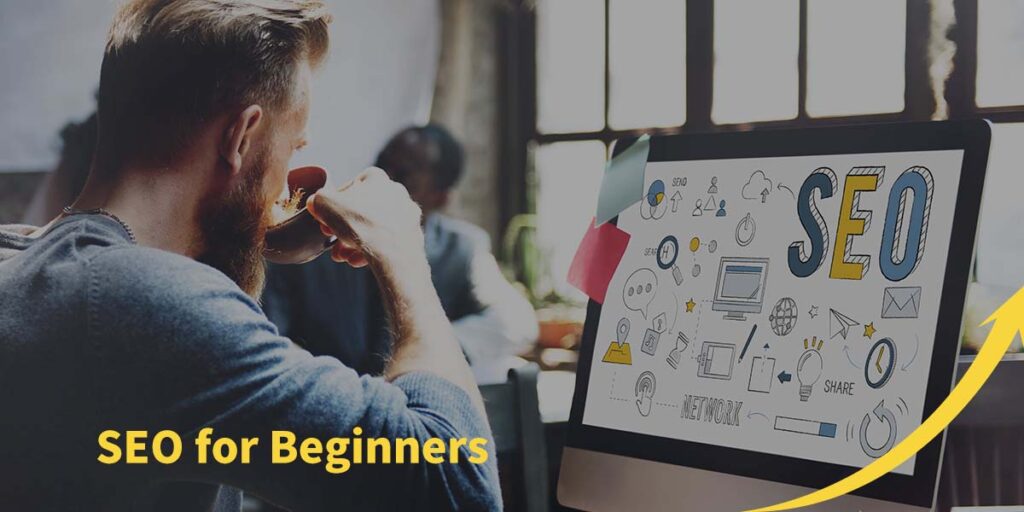Search engine optimization is vital for your website’s success. Besides getting you more visitors online, it will provide more opportunities to convert them into leads/sales and help ensure that everything on your website is working as it should. This beginner’s guide shows you how to get started.

Table of Contents
- Do analytics
- Do keyword research
- Create effective content
- Optimize your on-page SEO
- Improve your off-page SEO
- Enhance user-experience
- Optimize for Mobile
- Improve your website’s speed
- Conclusion
Do analytics
A single piece of information can’t do you much good, but when you start to gather large amounts, you’ll see patterns of behavior that can be exploited.
Evaluating user behavior reports and search engine traffic data (from Google, Bing, yahoo, and so on) will show you how people behave once they enter your website. For example, user behavior reports will show you which actions people take once they find your site, while tools like Google search console will evaluate critical metrics, like bounce rate, number of sessions, and others.
Study this data for specific trends. Your referral sources (how visitors find your site), for instance, can reveal lots of information about your audience. You could also look at the pages that are winning more traffic and conversions than others. Study what makes them so successful and apply it to other sections of your website.
Do keyword research
A short while ago, you could dream up a keyword, write a 500-word article on it, and it would rank for that phrase in 24 hours. Things aren’t that simple anymore – you’ll need to do more.
Tools like Moz keyword explorer and answer the public will help you discover keyphrases relevant to your target market. Use them to identify long-tail keywords that match your target customer’s search intent.
Note: Long-tail keywords are long, highly-specific key phrases internet users are likely to use (like “buy chocolate-flavored cream cake) when they’re close to making purchases or using voice search services. They can seem unusual, but they’re very valuable if you know how to exploit them.
Create effective content
Crafting great content takes sacrifice, but it’s always worth it. You could take the easy way and write low-quality content, but it’s a path that won’t get satisfactory results.
To create compelling content, you’ll need to
Make your content compelling.
Your content assets need to convey value. They should answer your target audience’s immediate questions. Make this clear in the title. The more concise it is, the more people will want to click it.
There is the possibility you’ll overpromise (think clickbait) but, the key is to clearly state why you’re content is essential to your audience. Let’s say you’ve designed a resource that provides information on a specific sector within your industry. Use that for the title instead of a generic heading.
Make your content fulfilling.

If your content promises value, it must deliver. This helps you keep your readers happy and increases the likelihood that your content will be shared/recommended amongst peer communities.
Your audience’s expectations can take many forms, so if you promise something in the title, be sure to fulfill that commitment in your content. Don’t call your one-page document a white paper. Your readers won’t like it.
Maximize convenience
You should provide your content in the ideal format for the target audience. For example, detailed information might require illustrations, and you can’t deliver it by podcast. The perfect approach would be to offer your content in several different formats and let your audience choose which works best for them.
Ensure efficiency
Content costs money. So, you should carefully manage your content creation schedule to maximize efficiency. Reusing your content assets in different formats, like converting your podcast interview into an article, can help enhance your content’s effectiveness.
Optimize your on-page SEO
On-page SEO involves optimizing your website pages. It deals with factors like Meta tags, URLs, headlines, and subheadlines.
Your headlines should always have the primary keyword for that page (the primary keyword most closely describes what the page is about), preferably as close to the beginning as possible. The primary keyword should occur in the slug (the part of the URL that defines a specific page in an easily readably readable format) and some of your subheadlines. Aim for 0.5 – 2.5% density throughout the page’s copy.
Note: remember to distribute your keywords evenly throughout the page’s body. Add lots of context for each mention, so the search engines understand what you’re about.-
Improve your off-page SEO
Off-page SEO deals with all the strategies that enhance your website’s performance via external factors. This includes social media, guest blogging, brand mentions, and influencer marketing. They’ll all help you improve your site’s search performance.
Get relevant backlinks
Backlinks join webpages one webpage to another. Search engines consider inbound links as votes for a specific page, so the more backlinks one has, the better it will perform in search results.

Furthermore, as previously mentioned, writing informative, value-rich articles increases the chances readers will appreciate and recommend your work, which will help you get more links.
Optimize for Mobile
With such a large number of internet users visiting websites via mobile, it would cost you not to convert them into leads and paying customers. In addition, after Google introduced the mobile-first index, your website will rank better if it favors mobile viewers.
The best way to enhance your website for mobile is through responsive design. This approach lets your site adjust to any screen size. You can get both premium and free word press themes with responsiveness pre-coded, which means you need not concern yourself with actual coding.
Improve your website’s speed
Load time is a critical factor for search engine optimization. Think of it this way; would you revisit a website if it took ages to load? It’s unlikely; you’ll find an alternative that works as it should.
Tools like Google’s page speed insights will help you evaluate how fast your website loads across multiple devices and offer suggestions on specific actions that will help your site load faster.
Enhance user-experience
User experience deals with how easy it is for visitors to navigate your website and find the information they want. A good user experience will leave your visitors contented, happy, and anxious for more.
To improve your users’ experience, you’ll want to focus more on the small details. For example, study your home page and map each element, from your logo and main navigation bar to the sidebar widgets. Would removing any of those elements affect your user’s experience? If your answer is no. then remove it.
A better way to improve your user experience is by studying user behavior reports, which will show you heat maps (how people behave when they’re on your website). You can use them to identify which parts of your pages get the most clicks and then position your most important elements accordingly.
Conclusion
Search engine optimization can be broad and complex, but with these basics, you’re good to go. If you’d also like a fulfillment partner for your business, Nextsmartship has a range of custom solutions guaranteed to help you succeed.
